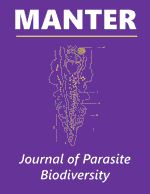Parasitology, Harold W. Manter Laboratory of
Date of this Version
9-1-2016
Document Type
Article
Citation
Supplemental to MANTER: Journal of Parasite Biodiversity (ISSN 2470-8224).
Occasional Papers, Number 4, September 1, 2016.
doi: 10.13014/K2057CV6.
Abstract
Mammals provide an important ecological habitat or niche space to microbial diversity, protistans (or protozoans) and metazoan parasites that can have profound effects on both human and animal health. Thus, understanding the status of mammalian species as hosts for pathogens holds relevance, especially during this time of anthropogenic environmental change. Despite the great diversity in the mammal fauna of Colombia, data in the literature on the occurrence of parasites and pathogens in these mammals are scarce and widely scattered. In order to understand the state of the knowledge of pathogens carried by wild mammals in Colombia, a systematic review of the literature was conducted. Information from scientific studies compiled included taxonomic orders, pathogens, natural regions, publication data (format, language, and region), funding sources, and affiliation of principal investigators. A total of 187 research studies fulfilled the inclusion criteria for this review. A total of 69,059 wild mammals belonging to 260 species and 12 taxonomic orders were studied in Colombia between 1876 and 2014. The most commonly researched orders were Rodentia (72 studies, n = 11,396 individuals sampled), Chiroptera (67 studies, n = 52,166), Didelphimorphia (55 studies, n = 2,447), and Primates (44 studies, n = 1,831), whereas the least studied included Lagomorpha (9 studies, n = 71), Paucituberculata (4 studies, n = 32), and Soricomorpha (3 studies, n = 3). No studies of pathogens of the Cetacea or Sirenia in the area of Colombia were found. The Andes natural region has been more extensively studied (53.7% of all studies conducted) compared to the rest of the country, and parasites have been the most extensively studied pathogen group, particularly the phyla Arthropoda and Platyhelminthes. Research funding was primarily provided by institutions in the United States. Similar numbers of studies were conducted by both private and public, national and foreign universities. This is the first systematic review of the literature focused on gathering all available data on pathogens in situ in Colombian mammals.


Comments
This paper was part of a symposium on mammal parasite biodiversity, organized by Scott Gardner and Jorge Salazar-Bravo, “CLM20 — Zoonosis y mamíferos Neotropicales” [Zoonoses and Neotropical Mammals], presented at III Congreso Latinoamericano de Mastozoología, Bogotá D.C., Colombia, 1 al 5 de diciembre del 2015.
Copyright 2016, the authors. Open access license, CC BY-NC-SA 4.0 International.
The archive of record for nomenclatural acts in this journal is the Internet Archive.